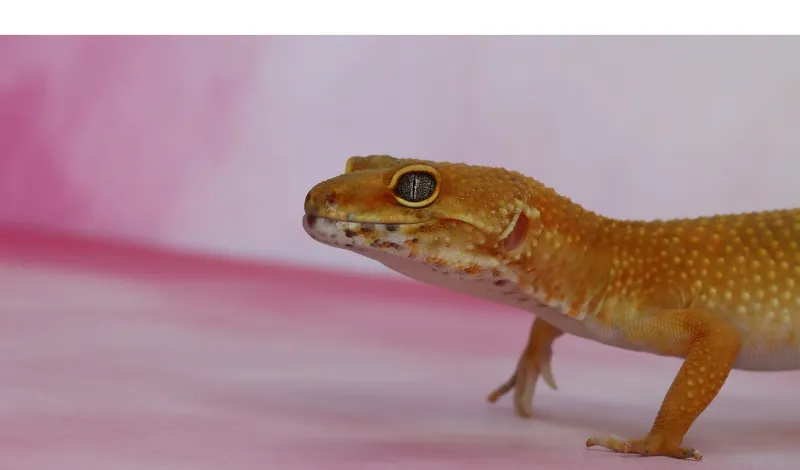Geckos are fascinating creatures with incredible abilities that make them stand out among reptiles. These little lizards have captivated the hearts of many, both in the wild and as popular pets. Can a gecko survive a fall?
That’s a question many gecko enthusiasts might have pondered. To answer this question, we first need to understand geckos’ unique features and adaptations.
In this blog post, we’ll dive into the world of geckos and explore how their anatomy and natural habitat play a role in their ability to withstand falls.
We’ll also discuss some practical tips for keeping your pet gecko safe and secure at home. So, whether you’re a gecko owner or just curious about these remarkable reptiles, let’s get started!
Fun Fact #1: Geckos have over 1,500 species worldwide, making them one of the most diverse groups of lizards!
The Gecko’s Anatomy and Adaptations for Survival
Geckos have evolved with some fascinating anatomical features that help them thrive in their natural environment.
These unique adaptations not only assist them in climbing and navigating their surroundings, but they also play a role in their ability to survive falls. Let’s take a closer look at some of these features.
Lightweight Body Structure
Most geckos are small and lightweight, which makes them less susceptible to injury during a fall. Their lightweight body means they have a lower terminal velocity, reducing the impact when they hit the ground.
This is crucial when considering how far of a fall can a gecko survive.
Specialized Feet for Climbing
One of the most iconic features of geckos is their specialized feet. Geckos have tiny hair-like structures called setae on their toes, which enable them to climb and grip various surfaces.
This adhesive ability allows them to scale walls quickly and even hang upside down, reducing the risk of falling in the first place.
Tail Autotomy: An Escape Mechanism
Geckos have a unique ability called tail autotomy, which allows them to detach their tail when threatened or grabbed by a predator.
This adaptation can also help them escape injury in the event of a fall, as their tail can act as a buffer and absorb some of the impacts.
Fun Fact #2: Geckos can communicate with each other through a variety of vocalizations, including chirps, barks, and clicks.
Can Geckos Survive a Fall?
Now that we understand some of the key adaptations that geckos possess, let’s address the burning question: Can a gecko survive a fall?
The answer largely depends on the height of the fall and the specific conditions surrounding the incident.
Height Factors and Terminal Velocity
Like many small animals, geckos have a lower terminal velocity due to their lightweight body structure. This means they reach a maximum speed when falling, which is much slower than larger animals, like humans.
As a result, they are less likely to suffer severe injuries or fatalities from a fall. However, no definitive answer exists to how far of a fall a gecko can survive.
Factors like the height, the surface they land on, and the angle of impact all play a role in determining the outcome.
Geckos’ Natural Habitat and Falling Scenarios
In the wild, geckos are skilled climbers that are adapted to living in trees, rock crevices, and other elevated environments. Falls do happen, but their unique features (as mentioned in the previous section) help protect them in most cases.
It’s important to remember that even though geckos have a higher chance of surviving a fall compared to other animals, it doesn’t mean they are invincible. Injuries can still occur, especially if the fall is from a significant height or onto a hard surface.
How to Keep Your Gecko Safe at Home
As a responsible gecko owner, minimizing the risk of falls and ensuring your pet’s safety is important. Here are some practical tips to help keep your gecko safe and secure in its enclosure.
Proper Enclosure Setup
Choose an appropriate enclosure for your gecko that provides enough space for them to move around and explore. Provide plenty of climbing opportunities, like branches, plants, and rocks, but make sure they are securely placed to prevent falls.
Keep the enclosure away from high-traffic areas or places where it might be accidentally knocked over.
Monitoring and Handling Tips
When handling your gecko, always be gentle and cautious. Support their body with your hands and avoid holding them too high above the ground. If your gecko seems stressed or tries to jump, lower your hands to reduce the risk of injury.
Monitor your gecko regularly for any signs of distress or injury and seek veterinary care if needed.
Following these tips can create a safe and comfortable environment for your pet gecko, minimizing the risk of falls and other hazards.
Conclusion: The Resilient Gecko
Geckos are remarkable creatures with unique adaptations that help them survive in their natural habitat.
When it comes to the question, “Can a gecko survive a fall?” the answer is generally yes, due to their lightweight body, specialized feet, and tail autotomy. However, it’s essential to remember that there is no guarantee of survival, as various factors come into play.
As a gecko owner, it’s your responsibility to ensure your pet’s safety by providing a proper enclosure setup and handling them with care.
Taking the necessary precautions can minimize the risk of falls and help your gecko live a happy, healthy life.
Read our related posts below;
- How long does it take for a leopard gecko’s tail to drop?
- How to know when leopard gecko is in pain?
- Does leopard gecko feel pain when they lose their tail?







![turn-gecko-lights-off-at-night]](https://www.howtoanimal.com/wp-content/uploads/2023/05/Featured_Image_turn-gecko-lights-off-at-night.webp)


